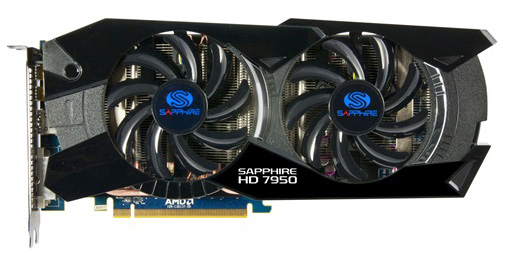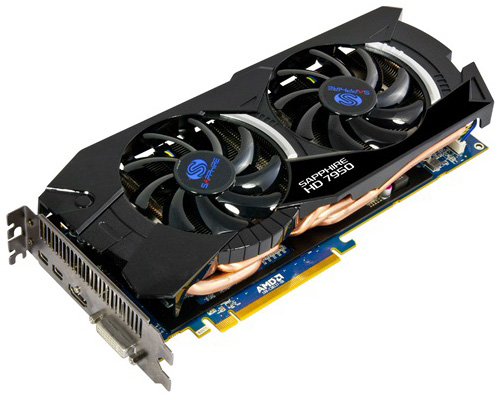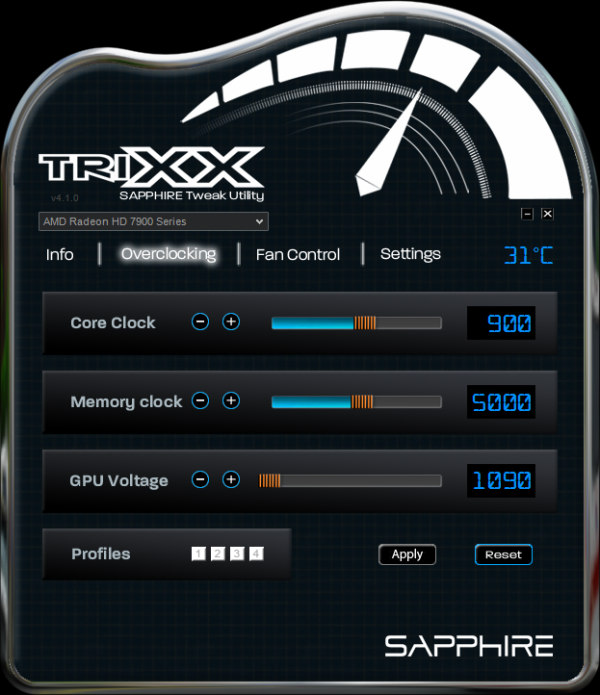AMD Radeon HD 7950 Review Feat. Sapphire & XFX: Sewing Up The High-End Market
by Ryan Smith on January 31, 2012 9:02 AM ESTMeet the Sapphire HD 7950 Overclock Edition
Since our reference 7950s are built on the 7970 PCB and cooler, we’re going to jump right into our vendor cards starting with the Sapphire HD 7950 Overclock Edition.
As with all of the 7950 cards launching today, Sapphire’s HD 7950 Overclock Edition uses the AMD 7950 PCB. This is a slightly shorter PCB measuring 10.25” long, saving .25” over the 7970 PCB by eliminating a few components that the lower board power of the 7950 makes unnecessary. The PCB is otherwise very similar to the 7970 PCB, utilizing 12 GDDR5 memory chips organized around the Tahiti GPU, while at the top you’ll find the 2 CrossFire connectors, a pair of 6pin PCIe power sockets, and the BIOS selection switch. The latter will be of particular interest to unlockers, as the switch should make it possible to safely attempt to unlock the 7950 into a 7970.

Moving on, as this is a semi-custom card the real differentiation is in the factory overclock and the cooler. On the performance side of things Sapphire will be shipping the 7950 Overclock Edition at 900MHz core and 5GHz memory, representing a 100MHz (12.5%) core overclock and no change on the memory clock.
Meanwhile for the cooler Sapphire is using what they’re calling the Dual-X cooler. The Dual-X is yet another double-wide dual-fan open air cooler, with 2 fans providing copious airflow over an aluminum heatsink running virtually the entire length of the card. Sapphire’s fan cutouts are just a bit bigger than most other dual-fan coolers and placed a bit higher, and as a result the Dual-X cooler is a bit taller than the PCB by about 15mm at its highest point. Meanwhile the cooler is also a fair bit longer than the PCB, putting the total card length at 11”.
Moving below the fans and the heatsink we’ll find the heatpipe assembly, which is responsible for carrying heat from the GPU to the heatsink. The Dual-X uses 5 copper heatpipes of varying radius that run from one end of the heatsink to the other. The 5 heatpipes converge at the base of the assembly, where a copper baseplate provides contact with the GPU. Meanwhile cooling for the VRM MOSFETs and RAM is provided by a black aluminum plate, which is placed over those components with heat transfer provided by the use of thermal pads. There is no connection between the plate and the heatsink, so the only heat dissipation from the plate is provided by whatever airflow from the fans reaches the plate.

At the front of the card we’ll find the display ports, which as this is an AMD PCB the card utilizes the standard AMD 7000 series port configuration of 1 DL-DVI port, 1 HDMI port, and 2 mini-DisplayPorts. Filling out the second slot is the grating for ventilation, though even with the ventilation slot the usual precautions for an open-air cooler apply: you’ll need a case with enough airflow to handle the roughly 200W of heat the card is capable of dumping inside of your case.
Rounding out the package is the usual collection of dongles and materials. Sapphire includes 2 molex-to-6pin PCIe adaptors, an HDMI to DVI dongle, a miniDP to DisplayPort dongle, a DVI to VGA dongle, and a 1.8m HDMI cable. Along with the dongles Sapphire packs a quick start guide and a driver installation CD.
The only thing you won’t find packed in the box is TriXX, Sapphire’s in-house overclocking utility. TriXX has been around since the 6900 series, but as this is the first high-end Sapphire card we’ve reviewed since it was released, this is the first time we’ve had it available for a review.
Fundamentally TriXX is a fairly well designed, albeit barebones overclocking utility. Along with an info readout similar to GPU-Z, TriXX provides overclocking and fan control support for Sapphire’s cards, including support for custom fan profiles and more importantly voltage control. With TriXX it’s possible to overvolt most of Sapphire’s performance and high-end cards, and as Sapphire uses AMD reference PCBs it also works with any other cards using AMD’s PCBs.
Beyond these features there’s little more to TriXX. It’s not an all-encompassing video card utility like MSI’s Afterburner, which means it comes up short if you need more functionality but it's exactly what you need if you just want to overclock. To that end it’s a clear step up compared to most other manufacturer’s poorly designed utilities, and from a design perspective its only real sin is the hard to read blue-on-black text. Otherwise it’s a competent overclocking utility that does exactly what it’s supposed to and provides voltage control for those who need it.
Finally, Sapphire will be selling the 7950 OE for $479, $30 over the baseline 7950 MSRP. Meanwhile the warranty on their card is their standard 2 year warranty.















259 Comments
View All Comments
xeridea - Tuesday, January 31, 2012 - link
Tru Datxeridea - Tuesday, January 31, 2012 - link
But not as bad as the Obamination we are in today.bji - Tuesday, January 31, 2012 - link
Which is better than the Bush clusterf** we were in yesterday ...Sabresiberian - Tuesday, January 31, 2012 - link
Too bad we can't actually blame stupidity on some drug that we can prevent people from smoking.;)
dagamer34 - Tuesday, January 31, 2012 - link
So you want to wag your finger at AMD for trying to make money when Nvidia has decided not to show up for a few months? Everyone knows that competition drives lower prices and right now AMD doesn't have any at the truly high end. If you want the parts now, you can pay up or wait. It's that simple.I am actually glad AMD is competing at the truly high end again because it shows confidence in their products. Confident products = bolder designs in the long term.
chizow - Tuesday, January 31, 2012 - link
Actually I've been saying for years AMD missed an opportunity to profit by mispricing their RV770 badly. Ever since that time they've been trying to dig themselves out of the pricing mistake they caused, because as a direct result, Nvidia dropped their flagship single-GPU prices to $350-400 for the 2nd tier and $500 for the top single gpu. Since AMD's subsequent parts have always trailed Nvidia's same-gen parts, they were obviously forced to price their cards according to Nvidia's performance, which generally meant $400 or less.The problem is that SI offers none of the performance and value you would expect from a next-gen part, nor does it raise the bar for price/performance. It only manages to keep the status quo using last-gen metrics and the 7950 is direct proof of this. Its roughly the same price and performance as the GTX 580, which would've been great if this were 2010 when the GTX 580 launched, but its 2012 now.
arjuna1 - Tuesday, January 31, 2012 - link
leave it to an nvidia fanboy to twist facts around as needed to put nvidia on top.chizow - Tuesday, January 31, 2012 - link
I didn't say Nvidia was on top...But honestly, as an ATI fan take a look at the 6970 results compared to the 7950 and then ask yourself if you really think the 7950 is worth the price at $450-500 compared to the $300-350 for a 6970....
I mean if you thought the 6970 was a great deal compared to the GTX 580 how on earth could you think the 7950 is some amazing bargain some 14 months later?
Galidou - Tuesday, January 31, 2012 - link
OMG and you just realized that? Welcome in 2012, you hav ebeen sleeping for the last 20 years?!?Video card manufacturers have done that a thousand times before... Nvidia and Ati with their rebranding and next gen higher priced than last gen for the same performance... The top segment was never meant to be performance/price top of the chart.... OMG.
So by listening to what you said from the beginning, anything below gtx 580 is useless, because you can find last gen video card lower priced for more or same performance, because of the next-gen price premium... HELLO!?! wake up...
You can find gtx 480's at a way lower price than gtx 570's on the bay for about the same performance...
You can find radeon 4870 about half the price of 6770's for about the same performance....
And so on....
chizow - Tuesday, January 31, 2012 - link
I don't think you understand that in your attempt to discredit my point, you've actually completely validated it.Yes, historically when a new part releases it compresses prices and forces older last-gen parts to drop in price as the new price:performance metrics dictate a drop in price with the next-gen level of performance.
None of this is occurring with SI because AMD has priced this part exactly where its performance lies because they are basing this on last-gen metrics. If anything, lower tier parts are probably UNDER priced relative to performance compared to SI and have no reason to drop in price.